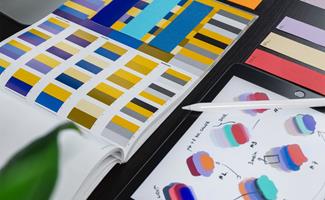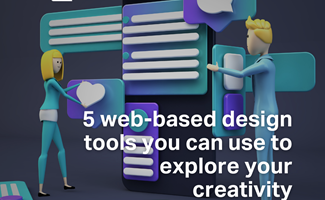Some people might assume visual communication and graphic design are the same concepts because they both involve design. However, this is not the case in reality; they may have some similarities, but are not the same.
Read on to learn more about these concepts and the differences that exist between them.
What is visual communication?
Visual communication refers to any non-verbal communication that uses the sense of sight. It involves anything that expresses a message and offers information with the assistance of various gestures, signs or postures. It is also known as viscom in some circles.
Visual communication design is only possible with the help of visual aids that are read or seen to communicate information and ideas. Take a look at some of the mediums of the same:
- Objects: this involves those items that are used for demonstrating an explanation or putting a point across to the people with whom you are interacting with. It is an excellent visual aid because people can see exactly what you are communicating. The advantage of using this visual aid is that it is usually the centrepiece of the discussion, thus helping the audience to properly grasp the message.
- Models: these are considered to be representations of the objects on a much smaller scale, and are meant for objects that are immobile or large, for example teachers may use a model of the solar system to explain the concept to children.
- Graphs: when comparing or analysing two or more products or items, graphs are usually considered to be the best bet. There are numerous types of graphs that you can use to convey your message like pie graphs, bar graphs, line graphs, histograms and frequency polygons. A huge advantage of using graphs in your communications is that it helps the audience understand the exact differences in the value or quantity of the two products, thus creating a greater impact in the minds of the audience.
- Photographs: photographs are great tools when something needs to be explained in detail, for example, if you have to talk about the life of people living in slums, showing pictures to audience of the same will provide them with a greater understanding of the wider context.
- Maps: while talking about the details of a particular place or explaining the location of a particular place, maps are the best visual aid. The advantages of using maps is that they are simple to understand if only the requisite information is present on it.
- Videos: In terms of being used as visual aids, videos are the latest trends. They are often used as training aids in the form of lessons for students or used to inform the audience about the latest services and products offered by an organisation.
- Presentations: these are usually used in organisations to convey key points to the audience. Slide presentations add a visual element that help the audience comprehend the important message in an easier manner.
This is important for several reasons:
- Saves time: It is faster for people to process a visual sign as compared to a paragraph of text. Hence, using visual communication to relay a message to the audience can be done better and faster with the help of visuals.
- Increases clarity: this form of communication also helps improve the clarity of any information that is to be shared. People are drawn to products and services that use attractive images and graphics in their branding and advertisements.
- Helps in consistency: this aspect is successful when an organisation uses the original colours of its products during advertising process. Using the same logo and colours helps improve the brand image of a product and helps consumers identify the product.
- Greater retention of information: according to Inc, 84% of all communications were visual in nature throughout 2018. This is because people have greater retention when they see something compared to text. Hence, people looking to market their products and services aim for greater visual communication so that the information is retained by consumers for a longer duration.
- Easy to understand: this form of communication can even be understood by illiterate people, making it the preferred communication method for providing information to consumers. It may take more time to prepare a visual advertisement, but in the end, it will have better reach and traction.
What is graphic design?
Graphic design refers to the planning and projection of experiences and ideas with the help of textual and visual content. Another term for graphic design is communication design. This form of designing can be virtual or physical in nature, and it includes images and text. Some of the key elements of graphic design include colour, line, texture, shape, space, size and form. In most cases, these elements are used as a combination to create attractive and impactful designs.
Graphic design comprises several spheres and specialisations like motion graphics, computer graphic design, website graphic design and animation. Web graphic design is a field that gaining popularity over the last few years. People working in this area are responsible for creating easy to use, simple and aesthetically pleasing websites for clients.
Some of the popular job roles in graphic design include:
- Graphic Designer;
- Art Director;
- Visual Designer;
- User Experience (UX) Designer;
- Freelance Designer;
- Publication Designer;
- Web Designer.
Differences between visual communication and graphic design
|
Parameters |
Visual Communication |
Graphic Design |
|
Focus |
Communicating with consumers using visual mediums, so students may be required to learn graphic design, animation, photography, illustration or airbrushing. |
Has a narrow focus as it only focuses on creating graphics for websites, advertising campaigns and marketing materials. |
|
Tasks |
Tasks involve anything within the domain of visual communication, whether photography, editing, video-filming, preparing materials to share information with clients, etc. |
The tasks here include designing elements for print and digital platforms. |
|
Tools Used |
Illustrator, Adobe XD, Sketch and Photoshop. |
Illustrator, Photoshop, InDesign, Affinity Photo and Affinity Designer |
|
Another Term |
Viscom |
Communication design |
Careers in visual communication
Take a look at some of the jobs you can take up after earning a degree or completing a course in this field:
- Advertising Manager;
- Photojournalist;
- Communications Manager;
- Art and Design Director;
- Design Artist and Illustrator.
If you are interested in joining the domain of visual communication or graphic design, London College of Contemporary Arts (LCCA) offers a CPD in Visual Communication, HNC/HND in Graphic Design and BA (Hons) Graphic Design.
This article was written by Varun Mehta and edited by Anisa Choudhary.


 Why should you consider social and cultural contexts in your designs?
Why should you consider social and cultural contexts in your designs?  What Does a Graphic Designer do?
What Does a Graphic Designer do?  5 Web-based design tools you can use to explore your creativity!
5 Web-based design tools you can use to explore your creativity!  7 ways to improve your creativity as a graphic designer
7 ways to improve your creativity as a graphic designer